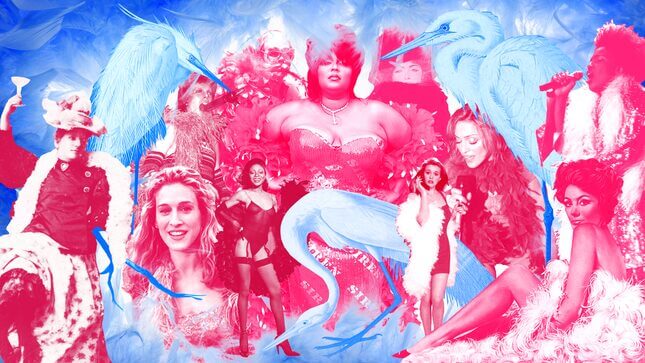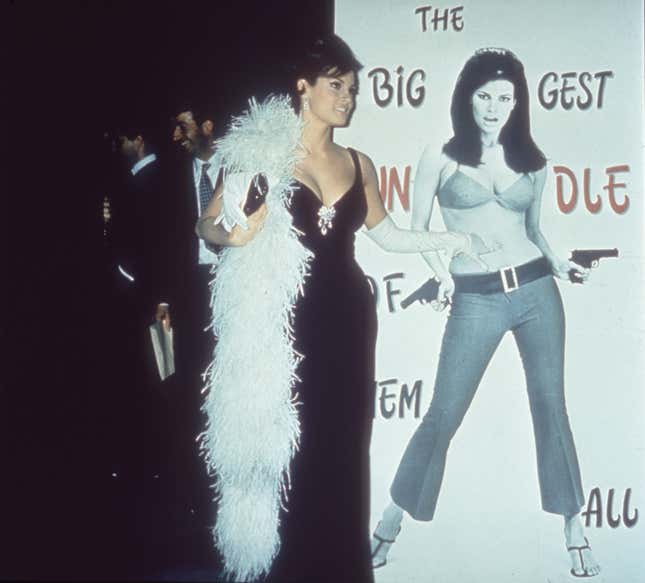Froth, Feathers, Fluff: The History of the Boa
In Depth
Illustration: Elena Scotti (Photos: Getty Images, AP, HBO)
Like many high school girls living in the early 2000s, I thought there was no higher fashion power in the universe than Carrie Bradshaw. I remember watching an episode from the first season, one of those frantic, self-encapsulated episodes that tells the whole story of a relationship in one 30-minute chunk. Carrie meets a Parisian man with a charming accent and a beautiful Roman nose; they go on a date; he leaves while she is still asleep. She awakes to an envelope full of money on the bedside table: one thousand dollars, cash.
I remember each beat of that episode, including the clothes. I especially remember her outfit for their date—a floral dress, a red coat, and rather horribly, a blue feather boa. A boa! Even I, a suburban teenager who knew little of high fashion, knew feather boas weren’t cool. Wait, were they?
When I first watched the episode, I thought the burlesque-esque accessory was foreshadowing. Perhaps the fancy rich Parisian misunderstood his date with Carrie because she had accessorized with such a gauche piece of neckwear. (Was this the implication of the costume design? I’m still not sure.) I had no idea that feather boas were once considered quite chic. I had no idea what a rich history, one intimately intertwined with Gilded Age riches and 20th-century subversion, Carrie was referencing with her fluffy blue scarf. Like too many viewers, I just saw the sugary fluff, rarely glimpsing the substance that gave the aspirational comedy its shape and structure.

Once upon a time, feathers were everywhere in New York City. On the pigeons and gulls, of course, but more importantly, they were all over the women. In the 19th century, it was fashionable to wear feathers on every part of your body from your hat to your heels (though not all at once, probably). While previous centuries saw men and women dressing in feathers, during the Regency feathers became more gender-coded, and by the Victorian Era, the trend had blossomed into a full-on craze, one that would leave a trail of carrion and carnage behind.
I’m not blaming women here, though women do deserve part of the blame; they were the ones walking around in hats festooned with taxidermy birds. But they weren’t the original pillagers of the avian species. That work was performed by men, as was the newly created job of the plumassier—i.e., one who grooms and sells ornamental feathers or plumes. “The plume trade was a sordid business,” William Souder noted in Smithsonian Magazine. “Hunters killed and skinned the mature birds, leaving orphaned hatchlings to starve or be eaten by crows.” According to the former chief tax taxidermist at the Smithsonian, a few rapacious plume seekers could wipe out an “entire rookery of several hundred birds” in just a couple of days. Hunters pillaged the wilds of North and South America, threatening dozens of species and causing several (including egrets and herons) to teeter on the edge of extinction. But it was a lucrative trade; accounts from the early 1900s say feathers could fetch up to $32 per ounce—twice their weight in gold.
Not all feathers made it onto hats. Quite a few made their way into long flexible scarves. (Preferred variety: turkey.) While Henri Bendel, founder of the now-shuttered department chain, claimed to have invented the feather boa, there are paintings of women in feathery tippets that predate his birth, so that seems unlikely. In 1888, a man named Rehul T. Bene of Hoboken, New Jersey filed a patent for “certain new and useful improvements in the manufacture of feather boas,” which made for cheaper, more durable, and more flexible boas. Bene had good timing, because this was the height of the boa craze. There are dozens of paintings from fin de siècle Paris, Vienna, London, and New York showing women wrapped in boas. One of the most famous boa-clad models was captured by Gustav Klimt in 1909 in a portrait that was purchased by Jewish owners, who were forced to sell the masterpiece when they fled from the Nazis. It took the Austrian government until the early 2000s to order it returned to the family—it had been hanging in the Austrian State Belvedere Museum for decades, alongside other art looted by Nazis.

But in fashion, accessibility breeds contempt. Just as fur coats went from a la mode to rather gauche as soon as a more diverse range of people began to wear them, so too did feather boas slip from grace. The fall began in the 1910s, after the newly-formed National Audubon Society successfully lobbied Congress to pass the Migratory Bird Act of 1913, which prohibited spring hunting of migratory birds (though later overturned, this act was the first of many that would reduce the supply of usable feathers by protecting avian species). The true death knell for boas came with the stock market crash of 1929, when the Roaring Twenties dramatically gave way to the austerity of the Great Depression. Even amongst those unscathed by the stock markets, frivolity and fluff felt wrong—tacky, tasteless. It makes sense that the 1930s were marked by serious glamour, like Joan Crawford’s severe dark suits and floor-length evening gowns and Katherine Hepburn’s button-up blouses and practical trousers. It was a serious time.
While the common gal most likely quit wearing so many feathers, the stars of Old Hollywood continued to wrap themselves in boas. But boas would never again be as essential an accessory as they were at the turn of the 20th century. They were a little too extra for everyday wear. With the invention of the bias cut dress in the 1930s, silhouettes became increasingly streamlined. The Space Age brought in a whole new era of aesthetics. People began to appreciate the spare, the clean, the sharp. America wasn’t as interested in fuzzy edges.
And thus feather boas became the sole province of the performer, an object more commonly viewed from a distance than worn on the body. Boas replicated, showing up in movies and fashion magazines, because they were worn by people whose bodies beget those sorts of images, whose physicality is replicated, people like Elizabeth Taylor (dubbed “the most beautiful woman in the world”) or Madonna (the so-called “queen of pop”). If you weren’t a performer, you were certainly performing something when you purchased a feather boa. Gender, perhaps, or your libido. You were showcasing your sense of irony, your rich understanding of camp.

Of course, Susan Sontag included the feather boa in her 1964 essay On Camp, alongside other ornate things I really like, including Tiffany lamps and Aubrey Beardsley drawings. For Sontag, the Gilded Age seemed to be the very apex of camp. Or maybe it’s that our appreciation for fin de siècle aesthetics would always feel a bit off-kilter, a bit campy, a bit gauche and dumb. The few times boas have returned to the spotlight, it tends to be in contexts either self-consciously playful (like Alicia Silverstone, dressed in bright red mini dress and a white feather boa, holding a chunky cellphone, standing atop the word Clueless) or straight-up goofy (hello, Miss Piggy). Sometimes, the boa wiggled with subversive power. The 1930s were the heyday of Mae West’s film career, but her sexed-up persona was an imaginative recreation of the racy late 19th century—and as she vamped her way across the screen, cracking assertive one-liners, she was frequently swathed in feathers. And too, the boa has long been an iconic object in the drag community going back decades—all the way back to drag balls of the sort West featured in The Drag, one of her many controversial productions. Drag queens have long wrapped themselves in brightly dyed feathers as part of their performance. But until recently, drag was an art form that remained firmly located in the subculture, rarely crossing into the mainstream. There was a moment in the ’90s when the feather boa felt just weird enough, just funny enough, to be considered cool (occasionally Kurt Cobain liked to wear one on stage). But that moment passed without too many people hopping on board. New York streets didn’t teem with feathers; Bradshaw walked alone.
But maybe feather boas could make a comeback in this wild and unpredictable time, when things feel unreal and all too serious and we’re craving a little madness, a little fluff. I think the time might be ripe. We’re seeing a revival of all things ’90s. Even the more questionable trends (oversized overalls, neon green high-neck tanks, yin-yang symbol earrings) have made a comeback. These are all objects I never thought I’d like, things that I wore in elementary school, if ever, and yet after seeing them on numerous funny TikTok teenagers, I’ve started to think they look kind of cool, maybe? Good? Could the right sassy 19-year-old make feather boas a thing? And, too, drag culture is more ubiquitous than ever, with boa-draped queens posing on the covers of magazines, glamorous testaments to the transporting glory of feathers.

Or maybe, just maybe, Lizzo could make it happen. The Grammy-award winning rapper has appeared decked in boas of all colors, from baby pink to candy red to slime green. She’s even appeared on the cover of British Vogue, wrapped in a black boa, looking chic as all hell. If, against all odds, 2020 turns out to be the year we take the boa out of the toddler’s toy box, maybe we should thank Lizzo. Maybe we should be grateful to have that brilliant plumage in our lives, that unserious glamour. Our gilded age is most likely over, but the party doesn’t have to stop.
Katy Kelleher is a writer who lives in the woods of Maine with her two dogs, one baby, and one husband. Her work has appeared in the New York Times, Longreads, The Paris Review, and the Guardian.